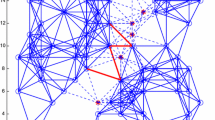Abstract
The paper introduces a geometric feature of separability of graphs for extremum equality-type boundary problems. To find an optimal value for a problem with an almost separable graph, the paper presents an iteration algorithm, each step of which minimizes Lagrangian function for the main variable with a fixed Lagrangian multiplier. This algorithm dates back to Krasovskii extremal shift method from differential game theory.
Similar content being viewed by others
REFERENCES
V. M. Alekseev, V. M. Tikhomirov, and S. V. Fomin, Optimal Control [in Russian], Nauka, Moscow (1979).
F. P. Vasil'ev, Numerical Methods of Solving Extremum Problems [in Russian], Nauka, Moscow (1980)
N. N. Krasovskii, Game Problems of Encounter of Motions [in Russian], Nauka, Moscow (1970).
N. N. Krasovskii and A. I. Subbotin, Positional Differential Games [in Russian], Nauka, Moscow (1974).
A. V. Kryazhimskii and Yu. S. Osipov, “On regularization of a convex extremum problem with inexact constraints. Application to the optimal control problem with phase constraints. Some methods of positional and programmed control,” UNTs, Sverdlovsk Sverdlovsk (1987), pp. 34-54.
B. N. Pshenichyi, Convex Analysis and Extremum Problems [in Russian], Nauka, Moscow (1980).
V. M. Tikhomirov, “The theory of extremum and extremum problems of the classical analysis,” in: Itogi Nauki Tekhn., Ser. Sovrem. Mat. Prilozh., VINITI, Moscow, 65, 189-258 (1999).
A. N. Tikhonov, F. P. Vasil'ev, M. M. Potapov, and A. D. Yurii, “On regularization of minimization problems on approximately given sets,” Vestn. Mosk. Univ., Ser. Vych. Mat. Kibern., No. 1, 4-19 (1977).
Fan Tzy, Theorems of Minimax. Infinite Antagonistic Games [Russian translation], Gos. Izd. Fiz.-Mat. Lit., Moscow (1963), pp. 31-39.
I. Ekeland and P. Themam, Convex Analysis and Variational Problems [Russian translation], Mir, Moscow (1979).
D. P Bertsekas, Constrained Optimization and Lagrange Multiplier Methods, Academ. Press., New York (1982).
Yu. M. Ermoliev, A. V. Kryazhimskii, and A. Ruszczynski, “Constraint aggregation principle in convex optimization,” Math. Program. Ser. B 76, 353-372 (1997).
A. Kryazhimskii, “Convex optimization via feedbacks,” SIAM J. Contr. Optimiz., 37, No. 1, 278-302 (1999).
A. Kryazhimskii, “Optimization problems with convex epigraphs. Application to optimal control,” Int. J. Appl. Math. Comput., 11, No. 4, 101-129 (2001).
A. Kryazhimskii and A. Ruszczynski, “Constraint aggregation in infinite-dimensional spaces and applications,” Intern. Institute Applied Systems Analysis, Laxenburg, Austria, Intern. Report IR-97-051 (1997).
R. T. Rockafellar and R. J.-B. Wets, Variational Analysis, Springer, Berlin (1998).
G. Sonnevend, “An analytic center for polyhedrons and new classes of global algorithms for linear (smooth, convex) programming,” Lecture Notes in Control and Optimization Series, Springer, 84 (1985), pp. 866-876.
W. I. Zangwill and C. B. Garcia, Pathways to Solutions, Fixed Points, and Equilibria, Prentice-Hall, Englewood Cliffs, New Jersey (1981).
Author information
Authors and Affiliations
Rights and permissions
About this article
Cite this article
Kryazhimskii, A.V., Osipov, Y.S. Extremum Problems with Separable Graphs. Cybernetics and Systems Analysis 38, 175–194 (2002). https://doi.org/10.1023/A:1016387227459
Issue Date:
DOI: https://doi.org/10.1023/A:1016387227459




